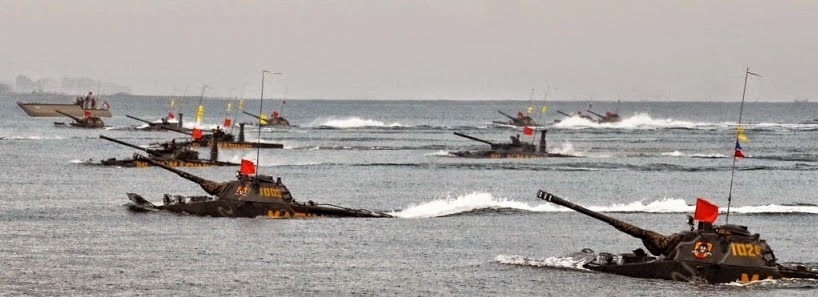The Japanese government’s recent decision to modify its
self-defense laws dating back to immediately after the Second World War has
sent shockwaves throughout East Asia. Some
Japanese and American officials are glad to see Japan taking greater
responsibility for their national defense, yet Japan’s military revival has
sent nerves wrangling in other parts of the region. The revisions in the
Japanese constitution’s Article 9 are likely to cause a stir in East Asia’s
delicate maritime security paradigm in particular.
As an island
nation, Japan depends a great deal on her navy for security. Japan is currently
locked into maritime disputes with three regional military powers: China,
Russia, and South Korea. Thus, a large part of Japan’s re-building of its
military will likely focus on its naval capabilities, as well as strategic
missile forces (which of course can be deployed in naval operations). The
Japanese Ministry of Defense has requested an increase in its
national defense budget for this year, a marked shift from the downward trend
in Japanese defense spending. According to figures from the International
Institute for Strategic Studies, Japan already had the 7th largest
defense budget in the world before the Ministry’s funds request.
Some experts
believe, however, that recent modifications to Japan’s laws and other actions
taken by the government aren’t as threatening as they seem. Garren Mulloy, an
expert on the Japanese military, believes that the idea that Japan is
re-militarizing is overblown, and that while the Japanese navy is one of the
best in the world, it would not likely be able to sustain combat with a country
such as China for more than a few weeks.
Much of the international
focus on Japan’s military budget increase and the related changes in Japanese
law has been on mounting tensions with China. Nevertheless, while many
countries in the Asia-Pacific region have bitter memories of Japanese militarism
from the Second World War, perhaps among the most apprehensive about the
re-emergence of Japan’s military complex is South Korea. Indeed, historic
memory dies hard in this part of the world. The Korean nation has billed itself
as a “shrimp among whales,” referring to its vulnerability against its historically
more powerful neighbors. Even 200 years after Japan’s invasion of Korea during
the Imjin Wars in the late 16th century, the Korean government has taken
strategic decisions--based in part on public fears--regarding the perceived
threat from Japan, even when no threat seems imminent.
The majority
of South Korea’s military is concentrated on its conventional infantry forces,
which are primarily prepared to engage in armed combat against a North Korean
invasion. Nevertheless, South Korea of late has been putting more resources
toward the development of a blue water navy, an initiative that began in 1995,
at the behest of Admiral An Pyong-tae. While South Korea’s navy has had a
global reach, such as participating in anti-piracy operations off the coast of
Somalia, it will likely continue to have an eye on Japan’s military, in
particular its navy, as it seeks to increase its own naval power. This comes in
no small part due to South Korea’s maritime disputes with Japan.
The United
States, a staunch ally of both Japan and South Korea, has welcomed a greater Japanese
role in its own defense and security. At the same time, the US is faced with a
delicate balancing act. The US military presence in both Japan and South Korea
serve the purpose of defending against North Korea as well as containing an
expansionist China. Japan and South Korea often begrudgingly accept their
status as strange bedfellows, brought together by the United States due to
their mutual fears of North Korea and, to a lesser extent, China. While a
greater amount of burden-sharing on Japan’s part may serve US interests as well
as Japanese pride, there is a risk that the fragile security balance in
Northeast Asia could become disrupted, and that the stable peace that currently
exists between Japan and South Korea could spiral into an unstable peace, or
even worse.
Japan remains
the home of the US Seventh Fleet, and the US must first and foremost defend its
own interests in the region. It’s possible that America may get caught between
two rising naval powers, both wed to the United States, and both suspicious of
each other. The US has been actively engaging in naval diplomacy in Northeast
Asia, sending clear messages to both China and North Korea. Earlier this year,
Japan, South Korea and the US participated in a two-day trilateral naval
exercise. The exercise was the first involving both Japan and South Korea since
the revisions in Japan’s self-defense laws. But nothing is written in stone,
and a stable security seascape is not something to take for granted.
Thus, at the
moment, it seems that Japan and the Republic of Korea will be on a relatively cooperative footing with regard to maritime security in Northeast Asia.
Nevertheless, as Japan’s naval power increases, states vested with security
interests in the region must be wary of possibly increased tensions between Japan and South
Korea. Indeed, as Professor Robert Kelly states, much of South Korea’s
diplomacy with Japan aims to isolate the country. Even if armed naval
confrontation between Japan and South Korea does not appear to be likely, the
increase of Japanese naval power risks exacerbating tensions in the region’s
delicate security balance.
